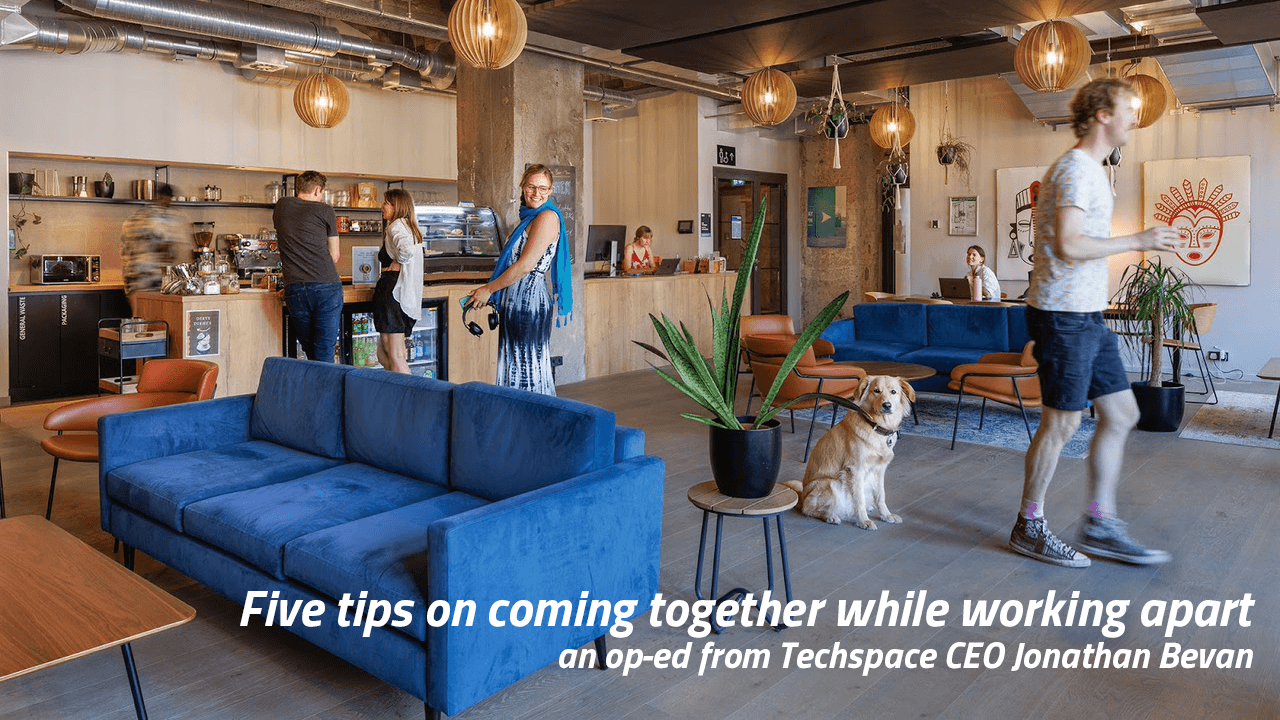Communication of company performance, direction and vision has never been more important for businesses. Typical ways of working have shifted since the events of 2020, with hybrid being the most common working structure according to Techspace’s The Scaleup Culture Report 2023.
The more dispersed teams become, the more deliberate teams need to be about making time for getting aligned and finessing their company culture. Using our report’s findings, here are five tips from businesses that are helping their employees come together.
Intentional workspace design
The way we use physical workspaces has changed dramatically, so it’s more important than ever to utilise them in the best way possible. This will be different for every business – when starting to design a space, consider what problems you’re trying to solve, your company culture and what budget you have to play with.

Look at what your team does best when working from home and from the office. Focus-intensive work, calls, or admin might well be best done at home, however creative work, camaraderie and collaboration is unlikely honed at home but when your team is together. Whatever you decide, be intentional about it and design your office to best facilitate that work. Our report found that 46% of employees said their employer hadn’t made adjustments to the office design to encourage them into the office. See it as an exciting opportunity to switch things up!
“With businesses spending less time together in-person, driving the right behaviour from your team when they’re together can be pivotal to company culture. The role of the office is likely to be different for every business, the key is understanding what activities act as force multipliers when team members are together, and then designing your office (and your week) with that in mind. If you have decided your office should be desks, task chairs and monitors, we would challenge you to think again.” - Jonathan Bevan, CEO at Techspace
Schedule all-in days
With hybrid working colleagues can feel like passing ships if there isn’t a clear structure to who is in and when during the week. According to our report, 73% of employees surveyed who work in tech want to engage with peers, and 46% want in-person meetings – so getting scheduling sorted and those all-in days pinned down is key.
Mirroring this, health scaleup Florence told us they’ve tightened up their company policy to ensure people come into the office on the same days. Matching schedules to be in the office at the same time helps colleagues to optimise cross-functional efficiency and create a working culture that is hard to replicate while being at home.
And it’s not just for operational and social benefit. Our report found that all learning, training and development can benefit from face-to-face interaction, a crucial part of business evolution.
As our members become more deliberate about bringing their teams together we are seeing greater demands on office design to accommodate this. “All-in-days” are a popular request across our portfolio, and we have responded by launching new products allowing members to book a combination of event spaces, meeting rooms, and hot-desking spaces throughout the year.
Inclusive, regular socials
Mobile food ordering and payments app Mr Yum told us they organise team breakfast and evening socials every fortnight, and we love that. Optimising the time spent together in an office doesn’t always have to mean heads down at your computer – having downtime where colleagues can catch up and get to know other teams is great for building a strong company culture and boosting morale.
When organising socials, be mindful of making them inclusive for all. Get-togethers outside of working hours or events centred around alcohol won’t work for everyone, so it’s essential you pencil in some regular time during a working day to shut down laptops and socialise.
Balance is healthy
Ensuring colleagues feel supported when working from home whilst feeling motivated and excited for days in the office is an important balance to achieve. We know from our report that tech workers want days when they don’t have to be in the office, but they also value togetherness.
You don’t have to dream up new ideas – our report found that snacks, refreshments and a free lunch on the company are key winning formulas.
The office is a key asset to any company. If you’re a business leader you need to think carefully about the in-office experience, and how this compliments and enhances the culture you want to build.
The annual get-together
Unicorn Pleo prides itself in arranging a company-wide team camp every year. Such get-togethers offer an opportunity to talk strategy, pitch new concepts, and get to know one another. They’re great for morale, too.
This approach is particularly fruitful for bigger businesses, especially those with international offices. The larger tech companies we surveyed tended to come into the office less often – a reason why it’s important to arrange a compulsory get-together annually that is both fun and business productive.
As the business grows the challenges evolve somewhat, businesses need to consider the practicalities of a weekly, or even monthly, all-in-day. Regular get-togethers often evolve to being focused on departments or cross functional teams that need to work well together. We know many of our global members, including Pleo, have chosen to organise an annual company get-together. The key here is to spend no more than 20% of the time on vision and strategy. The rest should be social time for employees to bond and build relationships with their colleagues.



Would you like to write the first comment?
Login to post comments